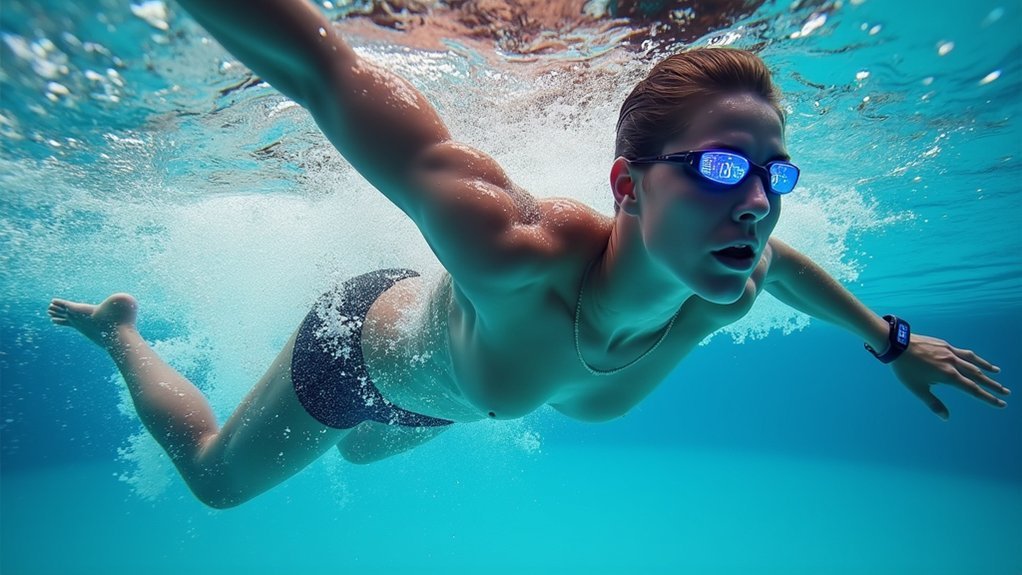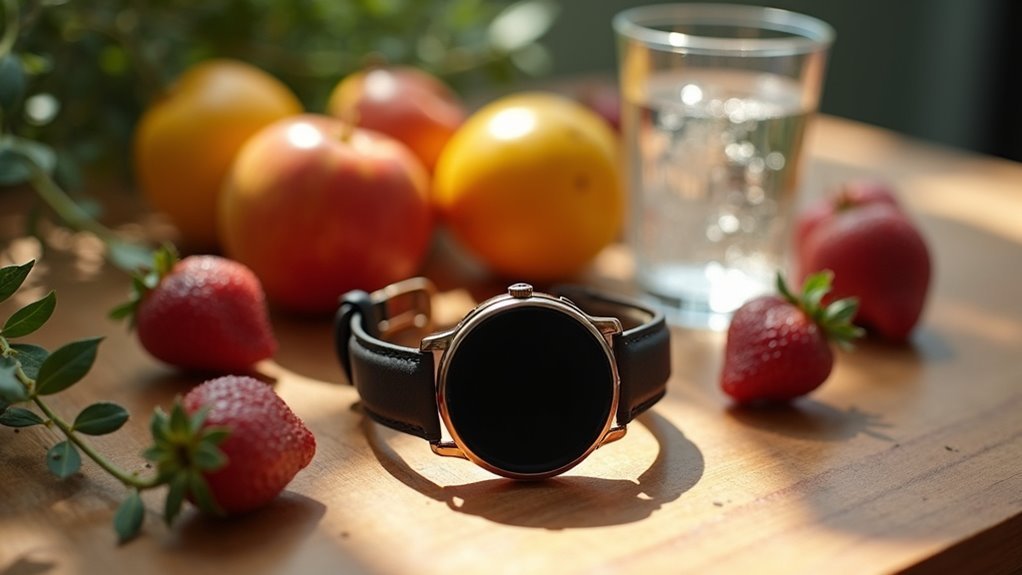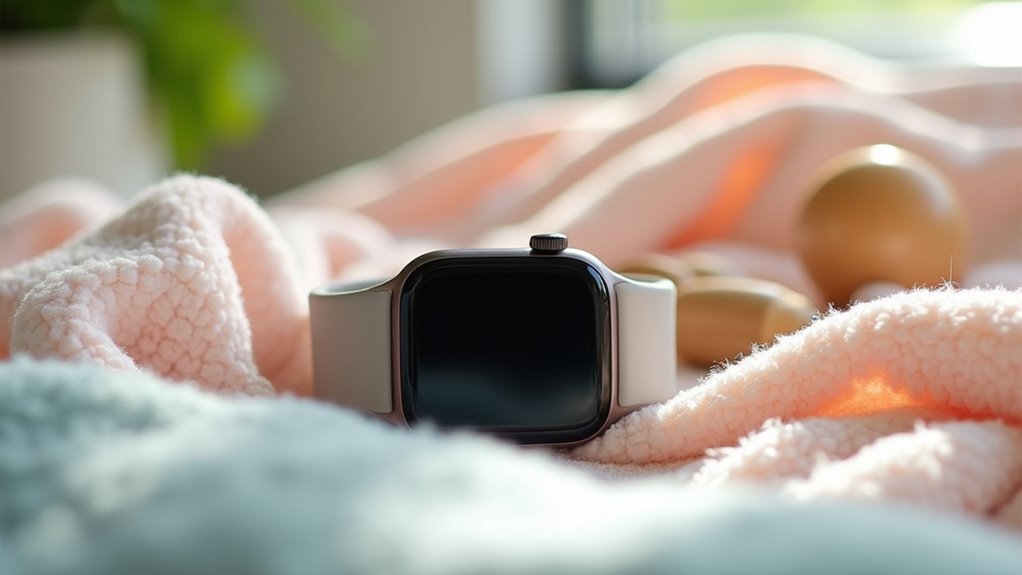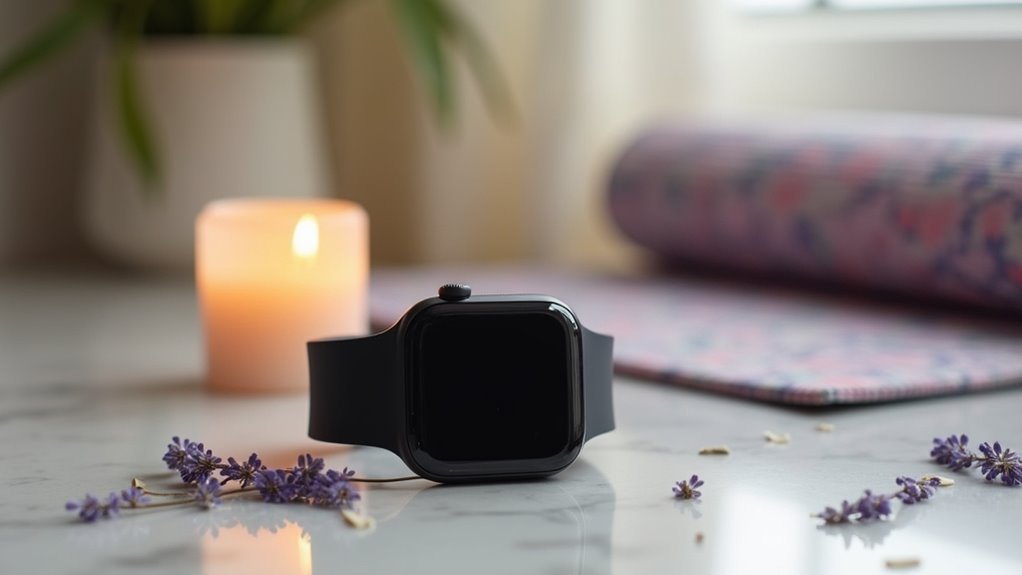You’ll need a waterproof sports watch with stroke recognition and SWOLF tracking capabilities to monitor advanced swimming metrics effectively. Focus on key data points like stroke count per length, pace variability, heart rate zones, and distance per stroke to assess your technique and efficiency. Set up your device with accurate pool length calibration and establish baseline metrics from initial sessions. Track SWOLF scores—combining time and stroke count—to measure overall performance improvements. These foundational steps will prepare you for thorough performance analysis.
Essential Swimming Metrics Every Athlete Should Monitor
While recreational swimmers might focus solely on completing their laps, serious athletes understand that meaningful progress requires tracking specific metrics that reveal performance patterns and guide training decisions.
Tracking performance metrics separates competitive swimmers from casual lap counters who simply aim to finish their workout.
You’ll want to monitor lap splits and pace to maintain sustainable speeds and gauge progress toward race goals. Track your stroke count per length alongside lap times to identify technical improvements—fewer strokes typically indicate better efficiency and glide.
Heart rate zones during sessions help evaluate your aerobic fitness and training intensity. Don’t overlook stroke rate, which balances speed with energy conservation.
Finally, monitor total distance and training load to prevent overtraining while maximizing gains. The SWOLF score combines your lap time and stroke count to provide a single efficiency measurement that helps identify overall performance improvements. These metrics collectively provide actionable insights for optimizing your swimming performance.
Choosing the Right Sports Watch for Pool Performance
Once you’ve identified which metrics matter most for your training goals, you’ll need reliable technology to capture and analyze this data accurately.
The right swimming watch transforms your pool sessions into data-rich training experiences that drive measurable improvement.
When selecting a pool performance watch, prioritize these essential features:
- Stroke recognition and SWOLF tracking for technique analysis and efficiency measurement
- 5 ATM water resistance minimum with corrosion-resistant materials for durability
- Real-time feedback capabilities allowing mid-workout performance adjustments
- Smartphone connectivity for thorough post-swim data review and workout logging
Popular options include the Garmin Swim 2 for dedicated swimming features, Apple Watch Ultra 2 for premium functionality, and Garmin Fenix 7 for multisport athletes seeking extensive training tools. Many advanced models now include heart rate monitoring through optical sensors that provide valuable cardiovascular data during your swim sessions.
Setting Up Your Wearable Device for Accurate Swim Tracking
Once you’ve chosen your sports watch, you’ll need to configure it properly to capture precise swimming data.
Your device’s accuracy depends on three critical setup areas: ensuring compatibility with your swimming needs, calibrating pool settings and environmental factors, and establishing reliable sync protocols for data management. For optimal performance, verify your device meets the minimum 5 ATM rating required for swimming applications.
Getting these fundamentals right from the start prevents frustrating data gaps and inaccurate metrics that can derail your training progress.
Device Selection and Compatibility
Choosing the right swimming device requires balancing your specific tracking needs with compatibility across your preferred platforms.
You’ll need to contemplate how well your device integrates with third-party apps and exports data to platforms like Strava or MySwimPro.
Key factors to evaluate when selecting your device:
- Water resistance rating – Verify your device handles deep water use like the Garmin Swim 2 or Apple Watch Series 8.
- Sensor accuracy – Different devices vary greatly in stroke detection and distance tracking precision.
- App ecosystem compatibility – Check if it syncs with your preferred swimming apps and fitness platforms.
- User interface readability – You’ll want clear displays that work underwater and easy controls for starting sessions.
Reflect on whether you need multi-sport tracking capabilities if you’re training across swimming, running, and cycling disciplines.
For improved heart rate accuracy during swim sessions, consider devices with chest strap compatibility since underwater pulse readings can be inconsistent.
Calibration and Pool Setup
After selecting your ideal swimming device, proper calibration and pool setup become your next priority for obtaining reliable metrics. Modern wearables automatically calibrate their accelerometers, but you’ll need to input your pool’s length for accurate distance calculations. Verify your device fits snugly to prevent water entry and maintain sensor contact.
| Setup Element | Best Practice |
|---|---|
| Pool Length | Measure and input exact distance |
| Device Fit | Secure snugly against skin |
| Swimming Form | Maintain consistent stroke technique |
| Turn Technique | Use strong wall push-offs |
| Rest Periods | Press pause or use auto-detection |
Consistent swimming form aids accurate tracking, while strong turn push-offs improve measurement precision. You can either manually pause during rest periods or rely on dynamic interval detection to automatically distinguish between swimming and recovery phases. Most devices offer custom pool sizes within specified ranges if your facility uses non-standard dimensions.
Sync and Data Management
While proper pool setup establishes the foundation for accurate tracking, seamless data synchronization guarantees you’ll capture and retain every valuable metric from your swim sessions.
Your wearable device’s data management system requires strategic configuration to maximize performance insights. First, verify your device pairs correctly with your chosen swim app—whether it’s Phlex Swim or Swim Smooth Guru—and check compatibility requirements.
Enable all necessary permissions for data transfer between your device and app to prevent tracking gaps.
Follow these essential sync practices:
- Pre-workout pairing: Confirm device connection before entering the pool
- Post-workout sync: Transfer data immediately after each session
- Cloud backup: Enable automatic cloud syncing for cross-device accessibility
- Regular maintenance: Clean and update your device to prevent data loss
Many swimmers find that maintaining consistent device pairing creates a more energetic atmosphere during training sessions, similar to how performers engage with their audience. Consistent syncing transforms raw swimming data into actionable performance intelligence.
Understanding Swolf Scores and Stroke Efficiency Data
The SWOLF score serves as swimming’s equivalent to golf scoring – the lower your number, the better your performance. This metric combines your time in seconds with stroke count for one pool length, creating a thorough efficiency measurement.
You’ll want to track both components separately since reducing strokes while maintaining speed indicates improved technique.
Your smartwatch or swimming app calculates SWOLF automatically for standard 25-meter or yard pools. Focus on balancing stroke rate with distance per stroke – taking fewer strokes doesn’t help if you’re swimming slower.
Consistent SWOLF scores across multiple lengths demonstrate reliable technique. You can improve your numbers through technique drills that emphasize stroke efficiency, pace management, and stroke count reduction while maintaining your swimming speed. Elite swimmers like Alexander Popov achieved remarkable scores of 45 for 50m by combining exceptional speed with minimal stroke counts.
Real-Time Heart Rate Monitoring During Swimming Sessions
Since modern swimming demands precise intensity control, real-time heart rate monitoring transforms your pool sessions from guesswork into data-driven training.
You’ll receive instant feedback that prevents overexertion while enhancing your workout efficiency.
Several waterproof devices deliver real-time heart rate data during swimming:
- Polar H10 chest strap – transmits data via GymLink to compatible devices
- Garmin HRM-Swim – specifically engineered for swimming sessions
- Chileaf Bluetooth armband – integrates with swimming goggles and provides vibration reminders
- FORM Smart Swim 2 goggles – incorporates heart rate monitoring with visual feedback
These devices enable personalized training regimens by helping you maintain ideal intensity levels.
You’ll develop competitive advantages through detailed performance insights while improving overall swimming efficiency. Heart rate monitoring helps differentiate between easy, moderate, and fast paces during your training sessions.
Real-time monitoring also assists with recovery assessment and stroke enhancement.
Analyzing Pace Variability and Distance Metrics
You’ll need to track how consistently you maintain your target pace throughout each swim session to identify performance patterns and areas for improvement.
Modern distance tracking tools like GPS swim watches, pool-based timing systems, and smartphone apps can measure your split times every 50 meters with precision down to hundredths of a second.
These measurements reveal whether you’re maintaining steady speeds or experiencing significant pace drops that indicate fatigue or pacing strategy issues. Elite swimmers who demonstrate effective pacing strategies in competition consistently show coefficients of variability below 0.5, indicating superior metabolic energy distribution throughout their races.
Measuring Pace Consistency
When analyzing your swimming performance, pace consistency serves as one of the most revealing indicators of your endurance capacity and technique stability.
You’ll want to focus on minimizing variability in your splits and stroke metrics to maintain even speed distribution throughout your swim.
To effectively measure pace consistency, track these key elements:
- Split time variations – Record lap times for equal distance segments to identify pacing fluctuations.
- Stroke count stability – Monitor strokes per length to detect technique breakdown or fatigue.
- Tempo maintenance – Track stroke rate consistency as it directly impacts your overall pace.
- Pace variability calculations – Use standard deviation or coefficient of variation to quantify fluctuations.
Your swimming watch or TrainingPeaks can automatically calculate these metrics, helping you identify when fatigue or technique changes affect your pacing strategy. As your fitness improves through consistent training, you’ll need to adjust swim zones regularly to maintain accurate performance benchmarks and ensure your pace consistency targets remain challenging yet achievable.
Distance Tracking Tools
While pace consistency reveals your endurance and technique stability, distance tracking tools provide the foundation for measuring these metrics accurately across different swimming environments.
GPS-based trackers excel in open water by detecting turns and strokes, though you’ll need accurate pool length settings for indoor training.
Digital swim goggles paired with smartwatches display real-time distance and split times directly on your lenses, eliminating the need to check pool clocks.
Advanced devices like the Garmin Forerunner 945 combine GPS and pool sensors for thorough analytics. You can customize pool length settings down to 20 meters for non-standard pools.
These tools automatically detect turns and integrate heart rate data, giving you immediate feedback on distance covered relative to effort expended. Many swimmers find stroke count tracking particularly valuable as it provides insight into technique efficiency alongside standard distance measurements.
Interpreting Advanced Stroke Count and Rhythm Analytics
Advanced stroke count and rhythm analytics transform raw swimming data into actionable insights that can dramatically improve your performance in the pool.
You’ll discover that lower stroke counts indicate more efficient swimming, reducing energy expenditure while maintaining speed. Elite swimmers consistently demonstrate very low stroke counts, providing benchmarks you can target.
Your stroke rate directly impacts swim pace, with ideal rates typically falling between 50-90 strokes per minute.
Here’s how to interpret these metrics effectively:
- Monitor stroke efficiency by measuring counts per 25 yards or 50 meters
- Calculate stroke rate by counting arm strokes over 30 seconds and doubling
- Correlate pace relationships – faster intervals require higher stroke rates
- Focus on technique refinement through catch, pull, rotation, and extension improvements
You’ll optimize different stroke rates for varying paces through consistent practice. The Swolf score provides a comprehensive efficiency metric by combining your swim time with stroke count per length.
Creating Data-Driven Training Plans From Your Metrics
Once you’ve gathered thorough swimming metrics, transforming that data into a structured training plan becomes your next critical step toward performance improvement.
Start by identifying key performance metrics that align with your racing goals—stroke rate, split times, and distance per stroke for technical focus, plus heart rate and fatigue markers for physiological monitoring.
Set SMART goals using your baseline data, making them specific and time-bound.
Design targeted training sets that incorporate these metrics, like progressive race-pace intervals while tracking stroke consistency. Use real-time feedback during practice to make instant adjustments and maintain technique under fatigue. Focus on propulsive force measurements to understand your power output and efficiency in the water.
Regularly review post-workout data to identify patterns and refine your training approach, ensuring continuous improvement through data-informed decisions.
Comparing Performance Trends Over Time for Continuous Improvement
As your swimming data accumulates across weeks and months, tracking performance trends becomes essential for identifying what’s actually working in your training.
You’ll need to establish benchmarks and compare sessions systematically to spot meaningful patterns in your progress.
Here’s how to analyze your performance trends effectively:
- Create baseline metrics from your initial training sessions to serve as comparison points for future performances.
- Use graphs and charts to visualize changes in stroke count, pace, and distance per stroke over time.
- Identify recurring patterns that reveal consistent strengths or persistent technical weaknesses in your swimming.
- Monitor consistency levels across training sessions to guarantee you’re maintaining steady improvement rather than fluctuating randomly.
This systematic approach transforms raw data into actionable insights for continuous performance enhancement. Focus on heart rate metrics to understand how your cardiovascular efficiency changes as your technique and fitness improve over time.
Frequently Asked Questions
How Do I Sync Swimming Data Between Different Devices and Apps?
You’ll sync swimming data by using cloud-enabled apps like MySwimPro that work across iOS and Android. Choose apps with wearable integration and web versions, ensuring your data automatically backs up and syncs between devices.
What’s the Best Way to Track Open Water Swimming Metrics Accurately?
You’ll get the most accurate open water swimming metrics by wearing a GPS-enabled smartwatch like Garmin, keeping it near the surface, and tracking distance, pace, stroke rate, and heart rate consistently.
Can I Track Swimming Metrics Without Purchasing Expensive Wearable Technology?
You can track swimming metrics using manual methods like poolside observers, pool clocks, stroke counting, and logbooks. Smartphone apps, video analysis, and coaching feedback provide affordable alternatives to expensive wearables.
How Often Should I Calibrate My Swimming Tracking Device for Accuracy?
You should calibrate your swimming device initially, then only when you notice distance errors or inconsistent lap detection. Check calibration after changing pools, firmware updates, or if you’re experiencing systematic over- or undercounting issues.
What Privacy Concerns Exist When Sharing Swimming Data With Apps?
You’re risking exposure of personal data including swim times, location tracking, and payment details. Apps may share your information with third parties, potentially compromising your privacy without clear consent.





Leave a Reply